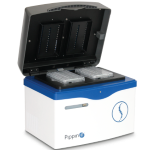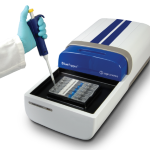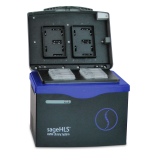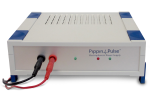SageELF Enables Targeted RenSeq Capture for PacBio Sequencing
We’ve had targeted capture on the brain lately as we work with collaborators to put the finishing touches on our HLS-CATCH method for selecting large genomic elements using Cas9 guides and the SageHLS system. So today, we wanted to revisit a great capture paper from scientists at the Earlham Institute and other organizations.
“Targeted capture and sequencing of gene-sized DNA molecules” came out in BioTechniques a year ago from lead author Michael Giolai, senior author Matthew Clark, and collaborators. It’s a terrific effort by scientists who know the value of nailing down every piece of a protocol in order to get the most robust, reliable results. For this method, the team focused on sample prep for the PacBio sequencing pipeline, and they made extensive use of the SageELF platform to optimize results.
Scientists began with RenSeq, short for R-gene enrichment sequencing, which was originally developed to help short-read sequencing platforms conquer challenging, highly repetitive sequence regions. In theory, incorporating long-read sequencing would be even more successful. “Here, we demonstrate that the use of RenSeq on DNA fragments up to 7-kb long in combination with PacBio sequencing results in full contig assemblies covering entire R-gene clusters with inter- and intragenic regions,” the team reported in BioTechniques. “Our approach can be used to capture, sequence, and distinguish between similar members of the NB-LRR gene family—key genes in plant immune systems.”
Giolai et al. focused on key steps in the RenSeq capture process: shearing, size selection, and PCR amplification. For more information about how the SageELF instrument makes a difference in this method, check out table 1 and figures 1 and 2 in the paper. Ultimately, the approach allows the PacBio platform to sequence only the longest fragments, generating the longest reads possible for a library and helping distinguish even high-identity sequences.
“This makes the optimized RenSeq protocol not only interesting for very accurate long-read R-gene enrichment,” the scientists noted, “but also as a robust and reproducible technique for the hybridization-based specific capture of fragments up to 7-kb in any genomic context—and it could be used for gap filling, other types of genome finishing, or structural variation verification.”
Fireworks, Genomics, and HLS-CATCH at AGBT in Orlando
The regular Super Bowl may have gone down last weekend, but the genomics Super Bowl is still to come with next week’s Advances in Genome Biology & Technology meeting in Orlando. The Sage Science team can’t wait. AGBT is our favorite one stop shop for cool new technology, amazing science, and legendary parties.
This year, we’re particularly excited about AGBT because one of our scientific collaborators, GiWon Shin from Stanford University, will be giving a talk about work involving a method we’ve been developing to target large genomic fragments and prepare them for the 10x Genomics workflow. We call it HLS-CATCH, and it involves our newest platform, the SageHLS instrument. If you’ll be at the conference, don’t miss his presentation: “Assembly-based structural variation and haplotypes from targeted sub-megabase DNA molecules” at 3:40 pm in the Tuesday afternoon plenary session about evolutionary genomes. (It’s right after Ed Green’s talk about pygmy genomes, sure to be a crowd pleaser.)
To learn more about HLS-CATCH — or just to enjoy Disney’s daily fireworks show at 8:00 pm — please visit us in our suite, room #1765 at the Hilton. The Sage team will be on hand to answer questions and help you determine whether our automated DNA sizing and preparation instruments could help with your research.
Finally, we’ll be presenting a poster (#305) about an integrated workflow for nanopore sequencing. Be sure to check it out during a dessert break or wine reception.
Happy AGBT, everyone!
Expert Q&A: Smithsonian Scientists on Evaluating DNA Quality
With the rapid adoption of long-read sequencing and other technologies that require high molecular weight DNA input, there is rising demand for high-quality samples from biorepositories around the world. To accommodate this, scientists at the Smithsonian Institution’s National Museum of Natural History in Washington, DC, developed and published a rapid, inexpensive method for quantifying DNA quality. We spoke with co-authors Jonathan Coddington and Daniel Mulcahy to learn more about this new technique.
Q: Why is there interest in working with high molecular weight DNA?
JC: We work for the Smithsonian Institution, so we’re in the forever business. We want to build a library of the highest-quality genetic resources for biodiversity. There are about 1.9 million species described and many, many millions more out there that haven’t been described — and we’re facing the sixth extinction crisis. So it’s important to collect and preserve samples that would have the maximum utility to science for many decades into the future.
DM: We’re interested in high molecular weight DNA because now it’s very practical to sequence the entire genome of non-model organisms. Even though you shear the DNA up to make the libraries, it’s better to start with big chunks of complete DNA so you’re shearing randomly across the genome, not as it’s been sheared through wear and tear.
JC: We’re also anticipating better technology in the future. Long-read technology is upon us, so everything from what you do in the field until when you extract the DNA needs to be adapted for very high molecular weight DNA.
Q: Before your method was published, how were people assessing sample quality?
DM: A lot of people were putting it on a spectrophotometer and looking at the concentrations. Another common way was to just PCR amplify short fragments, but that doesn’t really tell you if it’s high molecular weight DNA. There are more expensive methods as well, but we were trying to come up with an inexpensive way to quickly assess a lot of tissues based on DNA size.
JC: The concern with DNA quality has been around ever since the beginning of sequencing, but because PCR was so dominant people only measured the quality of their sample based on the marker that they wanted to amplify, not whole genomic DNA. An initial baseline assessment of the size frequency distribution for whole genomic DNA is almost never done in biodiversity biorepositories. We need to move the community to thinking about whole genomes.
Q: Have you seen signs that people are going in that direction?
JC: The sequencing research community has really moved beyond PCR marker-based sequencing. They want to do whole genomes and they’re looking to us to supply that high-quality DNA.
Q: How will having DNA quality information change how genomic scientists work?
DM: Our method can tell you how much of your sample was greater than the band you chose. Ultimately we’ll get to a point where we can sequence an entire chromosome; ideally you would want to be able to run the DNA out to the level where you can see various-sized chromosomes if it’s completely intact DNA. That’s where the future of this is going.
JC: Our paper was designed to enable a really cheap, really fast way for our community to inform people who want to do experiments what sort of quality DNA we might have. It’s a gel electrophoresis-based method because everybody can run gels.
Q: How will these quality assessments affect biorepositories?
JC: Dan and I represent a rapidly growing community of museums and other kinds of biorepositories. The Smithsonian, for example, has publicly about 90,000 samples. We’re also supporting an international network of biorepositories using a common data standard to report the existence and quality of samples that we all hold. The global total is about 615,000 publicly discoverable genetic resources. When we’re loaning out really rare samples, we want to know what you want to do with it. If you need the high-end stuff for a really good reason, we’ll give it to you.
DM: But if they don’t need it, we’ll give them lower-quality DNA to save the better stuff for someone who wants to do whole-genome assemblies.
Q: In the paper, you also looked at preservation methods. What were your key findings?
DM: That was a very preliminary study. If you stick a piece of muscle in the freezer and freeze it, it’s probably as good as it can be. But when you thaw it out, those proteins start to break down and the enzymes start to chew up the DNA.
JC: The DNases can still be active on the thaw cycle. I think the community assumption was that fresh frozen in liquid nitrogen was as good as it gets. What we found that was surprising was that saturating it in some sort of preservation buffer prior to freezing produces results that are better than just freezing. That’s the intriguing implication.
DM: We’re conducting a much longer-term study now. We’d like to see other people test this with other organisms, other buffers, and different storage methods.
San Diego Is Calling: Are You Ready for PAG?
It’s the start of a bright, shiny new year. If you’ve been in the genomics field long enough, you know that can mean only one thing: we’re getting ready for PAG!
Officially the Plant and Animal Genome XXVI Conference, this meeting attracts more than 3,000 scientists from around the world. Sociologically speaking, it’s a remarkable event: attendees sort themselves by the organism they study, leading to get-togethers of “cow people,” “oat people,” and so on. Each group has its own traditions, and the whole experience is really something.
Held this year from January 13-17, PAG promises to do what it does best: serve as the gathering place where all these individual communities come together to share updates on the latest science and technology. We always enjoy geeking out on the wealth of posters and catching some of the high-profile plenary talks. This year, we’re particularly looking forward to hearing from the University of Washington’s Jay Shendure, who will be speaking about new genomic frontiers, and USDA’s Doreen Ware, who has accomplished real breakthroughs for the maize community recently and will be presenting on agricultural challenges and opportunities from big data. PAG also keeps up with cutting-edge science; new workshops this year focus on paleogenomics, managing big data, and farming insects as a food source, among others.
If you’ll be attending PAG, please take a moment to swing by booth #422 to say hello to the Sage Science team. We’ll be showcasing our portfolio of automated DNA size selection projects, which can help increase average read lengths for PacBio and Oxford Nanopore sequencers, and improve the sequencing efficiency for Illumina sequencers. We’d be happy to hear about your research and figure out whether automated sizing could help you generate better results.
We hope to see you in San Diego. Have a great PAG, everyone!
New Mosquito Assembly to Accelerate Science and Insect Control
There’s a lot to love about the new preprint announcing the first-ever truly high-quality reference genome assembly for the Aedes aegypti mosquito. The large consortium of scientists — the paper features a total of 72 co-authors — came together on its own, with researchers signing on in droves after a tweeted plea from mosquito researcher Leslie Vosshall. The project took two years and yielded a remarkably complete assembly with a contig N50 of nearly 12 Mb. Here at Sage Science, we’re also delighted to see that two of our automated DNA size selection instruments, the SageELF and BluePippin, were used to prepare libraries for sequencing.
The preprint, currently titled “Improved Aedes aegypti mosquito reference genome assembly enables biological discovery and vector control,” comes from lead authors Benjamin Matthews, Olga Dudchenko, and Sarah Kingan. Scientists on the project hailed from Rockefeller University, Baylor College of Medicine, NHGRI, and dozens of other institutions.
Launched during the height of the Zika virus outbreak, the consortium aimed to generate a more complete and contiguous assembly for Aedes aegypti than was previously available. Since the mosquito genome is repetitive and spans more than a gigabase, prior assemblies were marked by thousands of gaps, short contigs, and sequence that couldn’t be mapped to chromosomes. “We used long-read Pacific Biosciences sequencing and Hi-C scaffolding to produce a new reference genome (AaegL5) that is highly contiguous, representing a decrease of 93% in the number of contigs, and anchored end-to-end to the three Ae. aegypti chromosomes,” the scientists report. They also produced a complete assembly of the mitochondrial genome with zero gaps.
Deep dives into the final assembly prove that it is more accurate and complete than previous resources, with more robust gene predictions. “The high-quality genome assembly and annotation described here will enable major advances in mosquito biology and has already allowed us to carry out a number of experiments that were previously impossible,” the team writes. For instance, they identified new candidate loci that appear to be associated with competence as a vector of dengue virus. They also learned more about the sex-determining mechanism, which is important for efforts to shift mosquito populations toward harmless-to-human males.
All in all, the scientists conclude, this new assembly should allow the community to make major strides in understanding mosquito biology and controlling their impact on human health.






